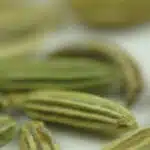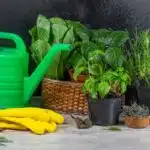Are you a beginner gardener looking to take your first steps in growing cilantro (Coriander)? If so, you have come to the right place! Growing cilantro can be a rewarding and delicious experience. In this article, we will discuss how to grow cilantro in your own backyard or garden space with ease. With some patience and dedication, you can have fresh cilantro all season long.
As a specialist in botany and gardening, I can tell you that growing cilantro is relatively easy. It is one of the most popular herbs used for both culinary and medicinal purposes around the world. This fragrant herb adds a wonderful flavor to many dishes, including salads, salsas, soups, curries, sauces and more. With proper care and attention, anyone can learn how to grow cilantro successfully.
In this article, I will provide useful information on how to cultivate this versatile herb from seed or plants while giving helpful tips on growing conditions such as soil type and sunlight requirements. By following these steps closely, you can enjoy an abundant harvest of fresh cilantro all year round! So let’s get started on this journey together towards cultivating a bountiful harvest of this fragrant herb for yourself or others around you.
Choose The Right Cilantro Variety
When it comes to growing cilantro, the right variety is key. It’s important to find a variety that is adapted to your local climate and soil type. There are two main types of cilantro – leafy green (Coriandrum sativum) or curly-leaved (Coriandrum innovatum). The leafy green variety has a milder flavor and does not bolt as quickly as the curly-leaved variety. Both varieties are easy to grow from seed, but the leafy green type has a higher germination rate.
Once you’ve chosen a cilantro variety, it’s time to prepare the soil for planting. Soil should be well-drained and fertile with plenty of organic matter such as compost or manure. Make sure to remove any weeds or debris from the area before planting. Additionally, it’s important to test the pH level of your soil so that you can adjust it if needed for optimal growth of your cilantro plants.
Finally, once your soil is ready and prepared, you can sow your cilantro seeds directly into the ground or start them indoors in containers and then transplant them outside once they have grown larger seedlings. For best results, make sure to keep the soil moist but not soggy during germination and provide adequate light for healthy growth throughout the season. With proper care and attention, you’ll be able enjoy fresh, homegrown cilantro all season long!
Preparing The Soil
One may question the significance of soil preparation when growing cilantro. However, this step is vital to ensure successful germination and maximum yields. Thus, it’s important to take the necessary steps to ensure that the soil is prepared properly before planting. Here are a few tips to help you prepare your soil for cilantro:
First, test the pH of your soil. Cilantro prefers soils with a pH between 6.0 and 6.5; if yours is outside of this range, consider amending it accordingly with lime or sulfur. Second, add some organic matter such as aged compost or aged manure to improve the texture and fertility of the soil. Third, work in some slow-release fertilizer into the top six inches for additional nutrients. Finally, rake the surface to make sure it’s even before planting your cilantro seeds.
In addition to testing and amending your soil, it’s important to loosen it up so that root development can occur easily and efficiently. For best results, use a spade or tiller to break up any large clumps of dirt before you start planting your cilantro seeds. With these simple steps in mind, you can rest assured that you are providing your cilantro plants with ideal conditions for optimal growth and development!
Planting Cilantro Seeds
Planting cilantro seeds is an easy task that can be done with a few simple steps. First, it’s important to ensure that the soil is well-drained and has a pH between 6.0 and 6.8, as this will help them germinate more quickly. To prepare the soil, you should add compost or aged manure to improve drainage and fertility.
Once the soil is ready, it’s time to plant the cilantro seeds. You’ll want to space them roughly 1/2 inch apart in rows spaced 10 inches apart from each other. Give the seeds a light covering of soil and water them gently so they don’t wash away. Germination usually occurs within 7-10 days after planting, so keep an eye on them for any signs of growth.
After your cilantro seeds have been planted, you’ll need to make sure they receive an adequate amount of moisture and fertilization throughout the growing season so they can thrive and produce lots of tasty leaves for your recipes! With proper care and attention, you can expect to harvest your cilantro in around 3 months time – just in time for summer salads! Next up: watering and fertilizing your cilantro plants for optimal growth!
Watering And Fertilizing
Watering and fertilizing your cilantro plants is akin to giving them a hug – it helps keep them strong and healthy. As a specialist in botany and gardening, I recommend providing your cilantro with an inch of water per week during the growing season, either directly or through irrigation methods like drip systems. If rainfall is insufficient, supplement the water needs of your plants by watering deeply every 7-10 days to ensure their continued health. Fertilization should be done about once a month using balanced fertilizer for vegetables. Be sure not to over-fertilize; too much nitrogen can cause lush foliage growth but reduce the production of flowers (and thus seeds).
For maximum effectiveness, apply fertilizer when you water. This allows it to be absorbed right away and helps prevent burning or other damage due to uneven application. Taking the time to properly fertilize your cilantro can help promote the plant’s nutrient uptake and maximize its overall health. Additionally, adding compost or aged manure will provide additional nourishment for optimal growth and development.
By following these simple steps, you can ensure that your cilantro plants get all the care needed for thick and healthy growth. The deep roots will then allow them to better withstand dry spells, making it easier for you to harvest fragrant leaves throughout the growing season!
Encouraging Thick And Healthy Growth
Once the cilantro is well established, it’s important to encourage thick and healthy growth. To do this, keep the soil evenly moist and make sure to water deeply. During periods of drought, it can be helpful to mulch around the plants with a few inches of organic material such as shredded leaves or compost. This will help retain moisture in the soil and reduce weeds.
Fertilizing cilantro can also help promote healthy growth. A light application of an all-purpose fertilizer every 4-6 weeks should suffice. It’s best to use a balanced fertilizer that has equal parts nitrogen, phosphorus, and potassium for optimal results. Avoid using a fertilizer that has too much nitrogen as this can cause excessive leafy growth at the expense of flowers and seeds.
Finally, keeping weeds under control is key in order to ensure plenty of air circulation around your plants. Hand-pulling any weeds you find is usually sufficient; however, if needed, an organic herbicide may be used on larger patches of weeds. This will keep them from competing with your cilantro for resources like water and nutrients.
Controlling Weeds
Weeding can be a chore, but it’s an important part of successful cilantro (coriander) cultivation. To ensure healthy growth of your cilantro plants, it’s essential to keep weeds at bay. Like many gardeners, you may be tempted to take the easy route and throw a blanket of herbicide on the area. However, this won’t help your cilantro and may even damage it in the long run.
For maximum weed control without using chemicals, start by removing any existing weeds before planting your cilantro seeds or seedlings. This involves hand-weeding or hoeing around your plants and is especially important for the first few weeks after planting when the young plants are vulnerable.
Mulching is another excellent way to combat weeds in your cilantro patch. A thick layer of mulch will act as an effective barrier against weeds while still allowing water and nutrients to reach your plants’ roots. Additionally, adding organic matter such as compost will further enrich the soil while suppressing weed growth. By taking these steps when growing cilantro, you’ll be well on your way to enjoying a bounty of fresh herbs!
Controlling Insects And Diseases
Controlling insects and diseases is one of the most critical steps in growing cilantro! It’s an absolute must if you want to ensure a bountiful harvest. As a specialist in botany and gardening, I can tell you with authority that outbreaks of pests or disease can ruin an entire crop in a matter of days. But never fear — with a few simple strategies, you can keep your cilantro safe from harm.
First, be sure to regularly inspect your plants for signs of pests or disease. Keep an eye out for anything unusual such as yellowing leaves, discolored spots, wilting, or stunted growth. If you spot any potential problems early on, it’ll be much easier to address them before they become too serious. Additionally, it’s important to keep your garden free from weeds; these can provide a home for pests and draw away vital nutrients from your cilantro plants.
Finally, there are several organic methods available to control insects and diseases without resorting to harsh chemicals. For example, introducing beneficial insects like ladybugs or lacewings into your garden can help combat problem pests naturally. You can also make homemade sprays using things like garlic or neem oil which are effective at repelling pests while being gentle enough not to damage the plant itself. With these tips in mind and a bit of diligence, you should have no trouble keeping your cilantro healthy!
Harvesting cilantro is the next step for growing this delicious herb...
Harvesting Cilantro
Harvesting cilantro is the final step in its cultivation. While it can be tempting to let nature take its course, harvesting cilantro correctly will ensure maximum yield and flavor. To reap the full benefits of this healthy herb, one must learn how to harvest it properly. As they say, practice makes perfect!
When harvesting cilantro, timing is key. When the leaves are young and tender, they contain more flavor and aroma than when they are older. If you wait too long to harvest, you risk losing out on the best flavors of your crop. You should also avoid harvesting more than a third of the plant at a time; leaving some foliage behind will ensure that your plant continues to thrive and produce more flavorful leaves in future harvests.
To begin harvesting cilantro, use a pair of sharp scissors or garden shears to cut off mature stalks close to the ground level. Make sure not to tug or pull on them as this could damage your plants’ roots and prevent future growth. Once you have collected your harvested cilantro, it’s time for storage!
Storing Cilantro
Storing cilantro is a critical step in preserving its flavor and making sure it lasts. With its unmistakable aroma, the herb can be used to bring out the taste of so many vibrant dishes. To get the most out of this fragrant addition to your cooking, let us explore how best to store it for maximum freshness.
Once you have harvested your cilantro, you should immediately wash and dry it off with paper towels. This will help remove any dirt or debris from the leaves and stems. Once dry, you can wrap the plant in a damp cloth and store it in a plastic bag inside your refrigerator for up to two weeks. This way, you can ensure that your cilantro remains fresh and full of flavor for when you need it!
An alternative method is to freeze cilantro as soon as possible after harvesting. Chop off the leaves and stems into small pieces then place them in an airtight container or freezer bag. Alternatively, puree them with a little water before freezing – this will allow you to add flavorful herb ice cubes to soups or sauces whenever needed! As long as they are stored properly, frozen leaves will last up to six months.
By following these simple steps, you can keep your cilantro fresher for longer periods of time – allowing you to enjoy its unique aroma whenever desired! Now that we have discussed proper storage techniques, let’s move on to discussing some helpful tips on growing cilantro successfully.
Cilantro Growing Tips
In this section, we’ll be discussing tips to help with your cilantro growing success. Growing cilantro is fairly simple and straightforward, but there are a few things you should keep in mind before getting started. Here are some of the most important cilantro growing tips to consider:
• Soil: Cilantro requires a well-drained, high-quality potting mix or garden soil that has a pH of 6.0 to 7.5. • Light: Cilantro needs at least 5 to 6 hours of sunlight per day for optimal growth. • Watering: Be sure to water your cilantro regularly and do not let it dry out. Aim for keeping the soil moist but never soggy. • Temperature: Cilantro grows best when temperatures are between 70°F and 80°F (21°C – 27°C). If temperatures exceed this range, the plants may bolt prematurely. • Fertilizer: A light application of balanced fertilizer every two weeks during active growth is important for producing quality leaves.
By following these tips, you can ensure that your cilantro plants have all they need to flourish in your garden or container planting setup! Regularly checking the soil moisture levels and providing enough light will go a long way towards keeping your cilantro healthy and happy throughout the season. Additionally, make sure not to overfertilize as this can cause leaf burn and nutrient deficiencies in your plants as well as lead to other problems down the road. With proper care and attention, you’ll be harvesting fresh cilantro in no time!
Common Problems With Cilantro
Interestingly, it’s quite common for cilantro plants to have problems during the growing process. This isn’t necessarily a cause for alarm, however, as there are some simple solutions that can help you get your cilantro back on track. As an expert in botany and gardening, I’d like to share my tips below so that you can continue growing your cilantro with success.
The first thing you should do when faced with issues growing cilantro is to pay close attention to the soil. Cilantro prefers well-drained soil with lots of organic matter, and it won’t flourish if the soil is too wet or acidic. If you’re not sure whether your soil meets these criteria, you might want to consider having a soil test done to determine its composition.
Additionally, cilantro tends to bolt—or flower prematurely—when temperatures climb too high. If this happens, you should harvest any leaves and use them in recipes right away because they’ll become bitter over time. To prevent bolting, try planting your cilantro in an area of the garden that’s partially shaded throughout the day or mulch around the plants to keep roots cool and moist.
Finally, be sure to water consistently so that the plants don’t dry out and always remove any weeds or debris from around them as they can compete for nutrients in the soil. By taking these steps, you’ll be able to enjoy fresh cilantro all season long!
Using Cilantro In Recipes
Cilantro, also known as coriander, is a herb that can bring freshness and depth of flavor to any dish. It’s an invaluable addition to the kitchen garden! Ready to learn how to use it in your recipes? Let’s dive in!
Like a butterfly, cilantro has two lives – one as a young seedling and one as a mature plant. Both phases offer unique opportunities for adding flavor to your favorite dishes. When used at its earliest stage, cilantro adds an interesting crunch to salads and salsas. As it matures, it provides fragrant leaves that infuse dishes with lively citrus-like notes.
When cooking with cilantro, it is important to remember that fresh leaves have a much more intense flavor than dried ones. To get the most out of this powerful herb, add the leaves towards the end of cooking so they retain their bright flavor. For an extra boost of flavor, try combining cilantro with other herbs like parsley or basil.
Whether you’re adding it at the beginning or end of cooking, there’s no denying that cilantro adds an undeniable zestiness to any dish. Its versatility and unique flavors make it a must-have in any kitchen garden! With these tips on using cilantro in recipes, you can now create delicious meals with ease.
Companion Planting With Cilantro
Are you looking for ways to maximize your cilantro (coriander) yield and ensure successful growth? Companion planting can be a great way to do this! But what is companion planting and how can it benefit your cilantro crop? Let’s take a look.
Companion planting is a type of garden layout that encourages plant growth. It involves grouping plants together in specific combinations that help each other grow better by providing benefits such as pest control, improved nutrition uptake, or better disease resistance. When it comes to cilantro, there are several companion plants that can help optimize its growth and production.
Tomatoes, peppers, carrots, squash, onions, garlic, beans, and marigolds are all good companion plants for cilantro. For example, tomatoes release nitrogen into the soil which helps promote healthy foliage growth in cilantro. Carrots and squash provide protection from harmful insects like aphids while marigolds act as natural pest repellents. Planting these vegetables near your cilantro will help create the ideal environment for optimal growth and productivity.
So if you want to get the most out of your cilantro crop, try out companion planting! Not only does it allow you to make use of available space in your garden more efficiently but it also provides essential nutrients and protection for your plants that will result in an abundance of flavorful herbs!
Cilantro Varieties To Try
Cilantro, also known as Coriander, is a hardy herb with a unique taste and fragrance. It has been used for centuries to add flavor and aroma to dishes around the world. But cilantro’s usefulness doesn’t end there; its varieties are often used in companion planting, making it an invaluable addition to any garden.
The wide range of cilantro available means that gardeners have plenty of options when it comes to selecting their plants. From the spicy ‘Santo’ to the milder ‘Leisure’, each variety offers something different in terms of flavor, color, and texture. Many varieties are suitable for both outdoor and indoor growing, giving gardeners even more opportunities to create delicious dishes with their harvest.
For those looking for an easy-to-grow variety of cilantro, look no further than the ‘Calypso’. This variety is perfect for novice gardeners because it is low maintenance and produces large leaves with a slightly nutty taste. It can also be harvested quickly, meaning you can enjoy your bounty sooner rather than later! With its versatility and ease of growth, the Calypso is a great choice for any gardener who wants to bring some flavor into their garden.
Whether you’re looking for robust flavor or something more delicate, there’s sure to be a cilantro variety that will fit your needs – take the time to explore them all! And once you’ve settled on one that’s right for you, it’ll be time to move onto cilantro propagation methods so you can start enjoying your own homegrown bounty in no time!
Cilantro Propagation
Propagating cilantro can be a rewarding and cost-effective way to grow the herb. However, there are certain conditions that must be met in order for the propagation process to be successful. This article will explore the 15 varieties of cilantro and the techniques necessary for successful propagation.
It is widely accepted that propagating cilantro from seed is the ideal method for growing it, as it allows for greater control over germination rates and disease prevention. While some gardeners may opt to purchase pre-packaged seedlings from a local nursery, these often come with their own set of risks regarding disease resistance and pests. Therefore, starting from seed is often recommended.
When choosing which variety of cilantro to propagate, there are several factors to consider such as climate, soil type, growth rate, and flavor profile. Each variety has its own unique characteristics that can help contribute to a successful harvest. Some popular varieties include ‘Confetti’, ‘Long Standing’, ‘Italian Parsley’, ‘Calypso’, and ‘Persian’. Additionally, there are organic options available in some areas that come with fewer potential issues related to pesticide use.
No matter which variety you choose, proper harvesting techniques should always be used when propagating cilantro plants. Planting at the right depth and providing adequate drainage ensures healthy roots develop quickly; while regularly watering helps keep foliage lush and green. Furthermore, deadheading spent flowers helps prevent self-sowing of unwanted seeds in your garden beds. Taking these steps will help ensure success when growing this delightful herb from seeds or transplants alike!
Frequently Asked Questions
What Is The Best Climate To Grow Cilantro In?
Cilantro, or coriander, is a fragrant and flavourful herb that is popular in many cuisines. It’s a hardy annual that can be grown in almost any climate – but it thrives best in warm weather when the temperature is consistently between 70-80°F.
The ideal cilantro growing environment consists of full sun and well-drained soil. Cilantro grows quickly and will flower and produce seed if given enough warmth and light. When the days are short, it will bolt (go to seed) faster than when grown during long sunny days with plenty of water. To maximize the amount of time your cilantro plants have before bolting, look for varieties that are slow to bolt such as ‘Santo’ or ‘Confetti’.
Given the right conditions, cilantro can be planted from spring into early summer – depending on your local climate. Planting in succession allows you to harvest fresh leaves throughout the season without having to replant each time. If you live in an area with hot summers, try planting semi-shade tolerant varieties such as ‘Long Standing’ or ‘Leisure’. These varieties may require extra attention with regards to watering and fertilizer but they tend to stay productive for longer periods of time than their full sun counterparts.
Cilantro can also be grown indoors in pots or window boxes during cooler months. Avoid fertilizers with high nitrogen content which encourages leaf growth at the expense of flowers and seeds – instead choose one specifically formulated for herbs like cilantro to keep your plants healthy while maximizing flavor production.
How Long Will It Take For Cilantro To Be Ready For Harvesting?
Growing cilantro, or coriander, is a rewarding process that can be enjoyed by gardeners of all levels. For those looking to reap the benefits of this fragrant herb, understanding the best climate conditions and how long it takes for harvesting is essential.
Juxtapositioning these two considerations – climate and time – provides a holistic view of cilantro cultivation. In terms of climate, this herb prefers cooler temperatures, ideally between 60-70 degrees Fahrenheit with partial sunlight. It also requires consistent moisture in order to flourish; if the soil dries out too quickly, you’ll need to take action to ensure adequate hydration.
When it comes to harvest time, you’ll want to pay close attention to the growth cycle of your cilantro plants. Most varieties are ready for harvesting after 45-60 days from sowing seeds or transplanting seedlings. That said, if the weather is warm and sunny you may find that your plants mature faster than expected so keep an eye out for signs of readiness. Once harvested, make sure to use your cilantro within a few days for optimal flavor and freshness!
By taking into account both climate conditions and growth cycles when planting cilantro, you’re setting yourself up for success in your gardening endeavors. With some patience and care, you can look forward to enjoying a bounty of flavorful herbs in no time!
How Often Should Cilantro Be Watered?
Growing cilantro (coriander) is a rewarding endeavour for any gardener. It is a fragrant and flavourful herb that can easily be incorporated into a wide range of dishes. To ensure the best possible outcome, it is important to understand how often cilantro should be watered.
Watering cilantro can present a challenge; too little water can cause the leaves to wilt, while too much will lead to root rot and other ailments. The key is moderation: water your cilantro deeply once or twice each week, allowing the soil to dry out between watering sessions. For best results, use lukewarm water and apply it around the base of the plant – avoid wetting the leaves as this could cause fungal diseases like powdery mildew.
When watering cilantro, pay attention to environmental factors such as wind and temperature – during hot summer days, you may need to water your plants more often than usual. If temperatures are cooler or if there is plenty of rain in your area, you may only need to water every couple of weeks or so. TIP: install mulch around your plants to help retain moisture levels in the soil for longer periods of time!
How Can I Prevent Cilantro From Bolting?
Growing cilantro, also known as coriander, can be rewarding and enjoyable. But it is important to understand how to prevent cilantro from bolting before you start planting. Bolting occurs when the plant produces flowers, then quickly goes to seed, leaving you with a bitter tasting herb instead of the flavorful leaves you were expecting. Here are four tips for preventing your cilantro plants from bolting:
One of the best ways to prevent bolting is to choose a slower growing variety of cilantro. Look for varieties that are labeled as slow-bolting or bolt-resistant. You should also be aware of your climate as warmer temperatures can cause some varieties of cilantro to bolt faster than others. In warm climates, consider planting in partial shade or early in the season when temperatures are cooler.
It’s also important to keep your cilantro well watered throughout its growth cycle. Make sure there is good drainage and water regularly but not too much so that the soil remains moist but not soggy. Mulching around your cilantro plants will also help keep moisture levels consistent and protect them from heat stress caused by direct sunlight.
Finally, keeping weeds away from your cilantro will reduce competition for nutrients and water which can help prevent premature flowering. Weeds draw moisture away from plants so keep an eye out for any weed growth near your herb bed and remove them promptly if necessary. With these simple steps you should be able to enjoy fresh homegrown herbs without worrying about bolting!
Can I Grow Cilantro From Cuttings?
Growing cilantro from cuttings is an excellent way to have a fresh supply of the herb. It’s also a great way to get an early start on the season if you’re eager for your harvest. Juxtaposed with starting from seed, growing from cuttings can produce results much faster.
To grow cilantro from cuttings, start by snipping off five-inch stems from existing plants. Be sure to use healthy stems that are free from any signs of disease or damage. Dip the ends of the stems into rooting hormone and then place them in a jar filled with water. Place the jar in indirect sunlight and keep it somewhere warm, such as near a window or heater vent. Change out the water every few days until roots begin to form, which should take about two weeks.
Once roots have formed, transfer each cutting into its own pot of soil mix made up of three parts potting soil and one part perlite or vermiculite. Keep the soil moist but not soggy, and remember to fertilize once every two weeks throughout the growing season with a high-quality liquid fertilizer that’s designed for herbs and vegetables. With proper care, your cilantro will be ready for harvest within four to six weeks!
TIP: When harvesting cilantro, snip off entire branches rather than just individual leaves so you don’t damage the plant’s root system. This will help ensure continued growth throughout the season!
Conclusion
As a specialist in botany and gardening, I can confidently say that growing cilantro is a breeze. With the right climate, regular watering and preventing it from bolting, you can have a crop of delicious cilantro in no time. It’s even possible to grow cilantro from cuttings if you’re feeling adventurous!
However, for those who are less experienced gardeners, growing cilantro may seem like an impossible task. It’s true that there is some effort involved when it comes to caring for this herb – but with patience and attention to detail, anyone can become an expert at cultivating the perfect crop of cilantro.
And don’t forget – once your cilantro has been harvested, you’ll be able to enjoy its unique flavor in soups, salads and other dishes. So why not take advantage of this opportunity to expand your culinary knowledge? After all, what better way is there to show off your hard-earned green thumb?





























